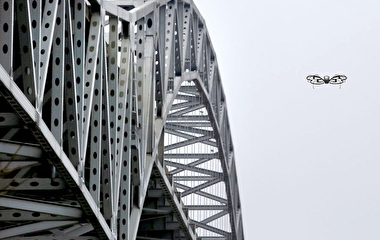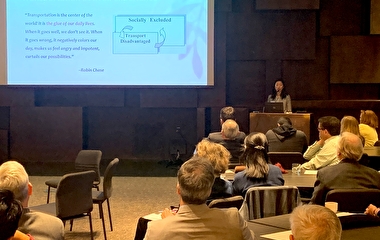Minneapolitan, is instrumented with a robust monitoring system.
Photo: Shutterstock
Maintaining the safety of bridges in the United States is a top concern for the transportation community. To improve bridge health monitoring, researchers have been seeking more effective technologies and methods. Using vibration measurements is one promising approach, especially as the required data acquisition and analysis systems become more affordable to deploy.
For this approach to be effective, the relationship between environmental factors and natural vibrations must be understood. U of M researchers led by Lauren Linderman, an assistant professor in the Department of Civil, Environmental, and Geo- Engineering (CEGE), recently completed a study that greatly increases knowledge of this relationship.
Others on the team included Professor Carol Shield and research assistant Karl Gaebler. Their project was sponsored by the Minnesota Department of Transportation.
“Using vibration data, it’s possible to monitor changes in the dynamic signature of a bridge to detect changes in the structure,” Linderman says. “However, this approach to monitoring has proven difficult because environmental factors, such as temperature, have been shown to cause variation in a bridge’s dynamic signature, effectively masking changes due to damage.”
Researchers began with data collected by a robust monitoring system on the I-35W St. Anthony Falls Bridge, which crosses the Mississippi River in Minneapolis. The system has been collecting vibration and temperature data since the bridge opening in 2008, providing a uniquely large data set—in a climate that sees extreme variation in temperature—to test the relationship between the dynamic signature of bridges and temperature.
Researchers faced a unique challenge of sorting through nearly 1.5 terabytes of high-quality vibration data to pinpoint the sections that would yield the most information about the bridge’s health. To solve this problem, Linderman’s team tested various signal-quality parameters and was able to identify a method that provides a strong indicator of a good signal.
“We developed an algorithm for identifying and sorting the natural frequencies and vibrations, then analyzed and tested nearly 30,000 unique data segments to demonstrate the viability of using the technique for systematic system identification with the available vibration measurements,” Linderman says.
The analysis allowed the researchers to draw several useful conclusions based on the variation of the natural frequencies with temperature. “This includes the finding that natural vibrations appear to generally decrease as temperature increases and that the magnitude of change in natural frequency as temperature varies is too great to attribute to temperature changes alone—meaning other factors, such as humidity, are likely at play,” Linderman says.
Moving forward, the researchers plan to identify and sort the vibrations resulting from temperature changes and other natural vibrations from those resulting from damage.




